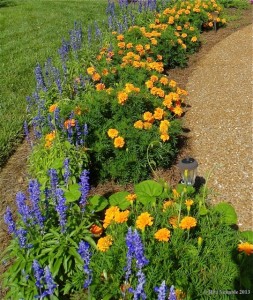What traits do you look for in a flowering plant to put in your garden? Some people want low maintenance plants with beautiful color and long-lasting blooms. Other individuals want fresh cut garden flowers to put in a vase for decorations. Some folks just want something that will stay alive and thrive.
Whatever your goals are with flowering plants, you might want to give “Merry golds” a try. Cultivated marigolds (Tagetes spp.) are bright and cheerful, easy to care for, and have long-lasting blooms that both people and butterflies relish. Marigolds bloom throughout the summer and last through fall, surviving several frosts. Throughout spring, summer, and fall they make lively, informal, cut flowers with attractive fern-like greenery.
Also, marigolds make good nectaring plants for Tennessee butterflies such as Dainty Sulphur, Gulf Fritillary, Monarch, Fiery Skipper, Tawny-edged Skipper, and Sachem. Since their blooms last even in cool weather, keep them around until they die back completely. Remember: Keep the butterfly restaurant open through November! Also, Dainty Sulphurs may use marigolds as hostplants.

My first garden, when I was a child, was a small plot of ground just outside my bedroom window. Mother showed me how to pull the weeds out, pick out rocks, smooth the dirt, and plant the marigold seeds we had bought. I watered and watched until finally, after a week or so, tiny green shoots appeared. What a thrill!
You can buy marigolds in flats, which are relatively inexpensive, or you can buy seeds in packets, which are even less expensive. They may be planted in the ground or in containers where they add a vivid splash of color. They like full sun and will grow in average soil. Once marigolds are established, all you have to do is keep them watered and deadheaded.
Planted in and around garden vegetables, marigolds deter nematodes. A word of caution, however, marigolds are poisonous especially to pets. If your cat or dog is in the habit of eating flowers, plant marigolds in places where they can’t reach them.
There are many different cultivars of marigolds available, and they grow to different heights. Find one that suits your garden needs, and enjoy these butterfly-friendly, easy growers.
©Rita Venable 2013
